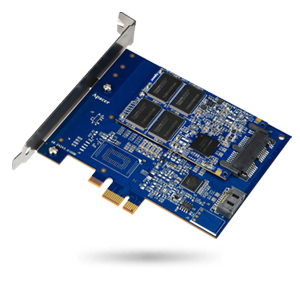Apacer, well known for their sizeable selection of memory products, has unveiled their PHFD hard drive caching solution.
Made available as a standard PCIe x1 add-in card, the new product will provide a separate 6Gbps SATA port, allowing users to utilize the HDD of their choice.
Initially, Apacer’s solution will only offer a cache size of 32GB, though this doesn’t preclude the possibility of larger capacities down the line.
An aspect about this announcement that is sure to be of particular interest to many potential buyers is the fact that they will be able to choose their own HDD. This is in contrast to products like OCZ’s Revodrive Hybrid, which saddles users with only one stock option when it comes to magnetic storage. Considering this, it seems that Apacer’s new product has a pretty sizeable advantage over OCZ’s offering. The only fly in the ointment I can think of would have to be the relatively small size of the PHFD’s 32GB cache, which pales in proportion to the 100GB reserved by the Revodrive. I have to wonder whether or not such a comparatively cramped cache will be able to effectively enhance the performance of the extremely high capacity hard drives available in today’s market. With multiple reviews likely coinciding with the SSDs imminent release, I’m sure we’ll find out soon enough.
Also pretty exciting is the controller hardware involved, which appears to be Marvell based. The main reason this is so appealing is that, up until now, the vast majority of SSD caching solutions have been based on NVELO’s software. While not necessarily a bad thing, it’s nice to see new players penetrate this promising new market. If Marvell’s take on SSD caching, known as HyperDuo, can manage to make a substantial impact on the industry, we may end up seeing this specialized segment taken to new heights, especially as more and more consumers seem to understand the many benefits of using SSDs to speed up magnetic storage. The only question now is when we can expect to see more disparate caching solutions descend on the market. Seeing as demand for these products is definitely on the rise, it appears that it is only a matter of time until we witness a tidal wave of new entries in this industry.
One more point I’d like to touch on is Apacer’s decision to use a PCIe x1 interface in their new device. Considering that fast flash memory can easily saturate 600MB/s, it’s somewhat surprising that Apacer would choose to implement such a narrow interconnect in their new offspring. On the other hand, it may be that the small amount of cache is well served by a relatively modest amount of bandwidth, with anything more being overkill. In addition, the incorporation of the most common PCIe width will undoubtedly make it easier for end users to efficiently utilize the expansion options on their motherboards, as PCIe X4 slots are generally in short supply. Those with multi-gpu configs will be especially appreciative of this fact.
All told, it seems Apacer has an interesting new product on its hands. Indeed, with the added flexibility of being able to choose your own flavor of magnetic storage, for many, this novel entry may end up being exactly what the doctor ordered. If Apacer can manage to ‘oppose’ the pricing status quo, and undercut the competition, they may end up ‘attract’ing a substantial number of customers. Truely, when it comes to this ‘field’ money really is one of the main ‘force’s to be reckoned with, especially if you want to get ahead in the ‘current’ market.
I have to say, Apacer’s new progeny really does have the potential to go ‘Far’. If the PHFD can deliver the promised performance enhancement when it’s released, it will most definitely be ‘a day’ to remember.
 The SSD Review The Worlds Dedicated SSD Education and Review Resource |
The SSD Review The Worlds Dedicated SSD Education and Review Resource | 
